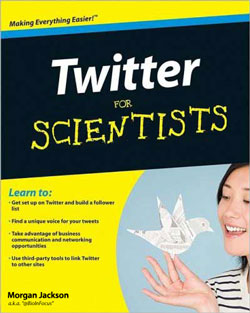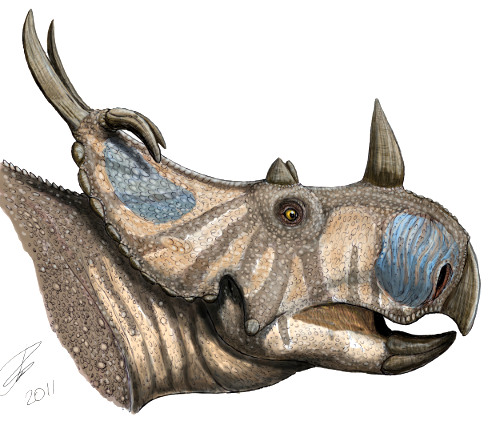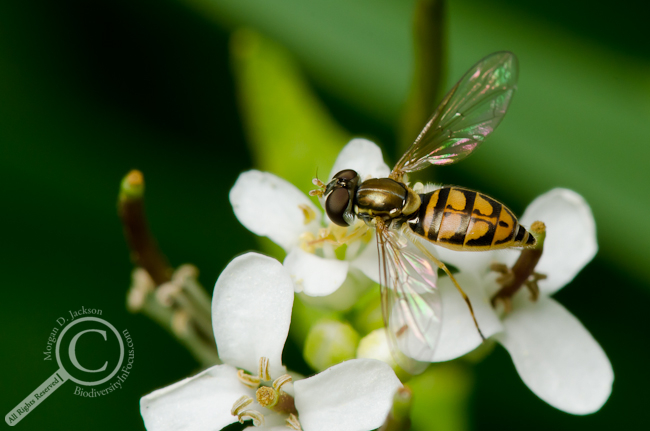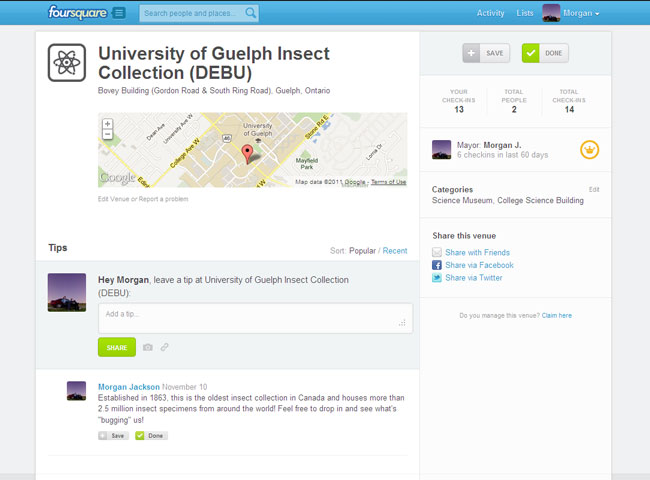Yesterday, UK photographer Paul Bunyard (@wildaboutimages) ran into a massive mating swarm of chironomid midges (family Chironomidae) while travelling through the Norfolk countryside, and shared some amazing images on Twitter (reproduced here with his permission).
I come across a large number of interesting blog posts, news articles, scientific papers and various other types of media every week, which I try and share through Twitter on a regular basis. Since I know not everyone has been bitten by the Twitter bug yet1, I figured I’d start a weekly round up of links to some of the stories I find interesting, important or just plain entertaining.
True to form, most of these links will be insect related, but I have broad interests, so some other topics are sure to turn up from time to time2. The internet is full of talented people, and I hope you enjoy their work as much as I have.
The Flies (Diptera)
The 8th International Congress of Dipterology is coming up in a few years, so be sure to start saving your pennies for the trip to Potsdam, Germany!
I prefer studying flies (dead or alive), but if that’s not your thing, check out these creative photos of dead house flies and blow flies having the times of their (already finished) lives. Here’s the full collection by photographer Nicholas Hendrickx.
The BugBlog has a nice series of photos of Helophilus pendulus, commonly called the Footballer Hoverfly in the UK. Why call it that, you might ask? Apparently the striped patterns on the thorax reminded someone of a soccer jersey.
The Dragonfly Lady shows off a nice hilltopping site in Arizona. Plenty of fly talk in the comments.
The Beetles (Coleoptera)
The Edmonton Journal has a great biography of Dr. George Ball, a beetle taxonomist at the University of Alberta who has impacted the careers of dozens of top entomologists across North America.
This short film is both beautiful and bizarre all at once. A stop-motion portrayal of the life of a beetle taxonomist who makes the discovery of a lifetime.
Emerald Ash Borer (Agrilus planipennis) has now been found in most major urban centres across Ontario, and has recently turned up in Quebec. Chris Buddle discusses the affect that EAB will have on Montreal.
While not EAB, Chrysobothris vivida looks quite similar on first glance. The Field Museum shows off the holotype and label data, helping to explain the role that natural history collections play in day to day science.
Speaking of natural history collections, a volunteer at the Natural History Museum in London, England shares why she loves helping out with the beetle collection in her spare time.
Check out this awesome longhorn beetle (Cerambycidae) Ted McRae of Beetles in the Bush came across while working in Argentina recently. While you’re there, share your ideas on the purpose of the strange tufts of hair!
The Ants, Bees, and Wasps (Hymenoptera)
The School of Ants is gearing up for another summer of discovery by sampling the ants around our houses and picnic areas.
Ants are to ________ as clown fish are to anemones. Think you know the answer? Better check Not Exactly Rocket Science (NERS) by Ed Yong for an excellent tale of commensalism.
It may not be 1984, but Big Brother is watching what Orchid Bees are up to (but don’t worry, it’s for a good reason).
Scientific American ran an interesting story about native bee populations in eastern North America, and included an excellent slideshow of some beautiful bees with it.
Some of photos in that slideshow came out of the Packer Bee Lab at York University, as did a newly published review and key to the Dufourea bees (Halictidae) of Canada in the Canadian Journal of Arthropod Identification.
Other Arthropods
Marine water striders (Gerridae) are making the news this week with the release of a new study finding that a massive raft of plastic pollution in the Pacific is harboring a growing population of these bugs. Ed Yong is excellent again on his NERS blog, and the paper is Open Access if you’d like to take a look yourself.
These plastic-loving water striders aren’t the only insects that have taken to the open ocean, and the North Carolina State University Insect Collection has a few more examples to share.
Caterpillars come in a wide variety of colours, shapes and forms, but these translucent, jelly Jewel Caterpillars are some of the most beautiful!
I saw Avengers this week, and it was really, really good. Prior to the movie, there was a trailer for the upcoming Spiderman reboot, promising plenty of web-slinging action. Before the movie comes out this summer, meet the backyard spider that may have served as inspiration for Peter Parker’s gadgets.
Taxonomy, Biodiversity, Academia, Science Communication/Photography
Although written by a marine ecologist and discussing a paper about plant taxonomists, this post on the Sea Monster Blog is one of the most best stories about the role of taxonomy and the decrease in taxonomists being hired and funded. A must read for anyone who depends on biology in their day-to-day lives (that means you).
The NCSU group shares an entertaining story and asks you to decide whether it’s fact or fiction. What do you think?
The Tepuis of Brazil are way up on the list of places I want to explore and collect one day. This excellent New York Times article by Carl Zimmer makes me want to go even more.
A new project was launched this week which hopes to provide interactive range maps for all the worlds flora & fauna! Nature has a nice feature explaining some of the goals and obstacles the project faces in the early phases. Right now they only have terrestrial vertebrates and North American freshwater fish mapped, but the interface is excellent and has a lot of potential! Now to get some insects into the project…
Most research papers only discuss results and experiments that worked. The Canadian Field Naturalists Blog discusses the importance of publishing projects which didn’t work as expected.
Just because it’s summer vacation for undergraduate university students, doesn’t mean their professors get a break too. Chris Buddle outlines some of his labs plans for the summer.
To get a job in academia, your peers (and more importantly, your hiring committees) need to know you and your work. But is all self-promotion viewed equally? Excellent discussion on the evolving role of social media and blogging to the world of academia by Scicurious.
Photography & Other Fun Stuff
Have you ever wondered what it’d be like to be a press photographer tasked with covering President Obama? This account by a Reuters photographer shows just how stressful the assignment can be.
I don’t know who started it, but the #InsectSongs suggested by Twitter users this week was an afternoon of hilarity. Check out some of my favourites, and then see which ones Bug Girl selected.
Finally, enjoy this fun stop-motion video detailing the everyday lives of insects.
————————
1- If you need more convincing why you should sign up for Twitter, here’s another excellent piece on the benefits of Twitter for academics
2- Ed Yong, and Bora Zivkovic do extensive weekly link round-ups covering a very broad spectrum of science writing if you need something else to read this weekend!
I’ve mentioned before how useful Twitter can be, and how the #hashtag can be a real life saver for researchers and entomologists. Today however, the #hashtag reached an all new level of awesome, and provided the Twitterverse with an afternoon’s worth of free comedy.
#InsectSongs is where cheesy Saturday afternoon music anthology commercials meet entomology, with countless creative song titles scrolling down the screen. I’ve Storified some of my favourites here (grouped by taxonomic order of course), but be sure to check out the full list of Bugboard 100 hit titles!
Insect nerds are a creative lot and they put their hivemind to work coming up with some amazingly Punny #InsectSongs!
http://storify.com/BioInFocus/insect-songs-for-the-ages
Ironically there were a large number of Beatles songs included in this list…
Of course if you want to hear some actual music about insects, check out my Tuesday Tunes playlist.
Another week, another Monday night blog challenge from the Bug Geek! Your challenge, should you choose to accept it, is explain your research in 250 words or less in a way that a 10-year-old could understand. Instead of banging my head against the wall on a manuscript (see earlier challenge) I tried my hand at explaining Diptera taxonomy.
What do I do for a living? I collect bugs! Not just any bugs though; I like to catch flies from around the world, bring them back to my laboratory, and figure out what their names are. Just like your parents gave you a name that’s special to you, scientists like me have given names to a lot of the flies around us. Many flies have long complicated names, like Drosophila melanogaster or Taeniaptera trivittata, but these names tell us who the fly is related to, just like your name.
Sometimes when I’m out collecting flies, I find one that has never been seen by a scientist before. That’s when my job gets really exciting, because I get to give that fly a new name! I can name a fly because of how it looks or how it lives, but sometimes I name the fly after someone important. As long as I know who it’s related to, I have lots of flexibility in naming!
There is so much about flies that we don’t know, which means plenty for me to learn. Most people think you need to travel to faraway jungles to find something exciting, but there are amazing new discoveries waiting for you in your own backyard. There may even be a new fly waiting to be discovered! Learning about flies at home and abroad helps us understand how they live their lives and why they look the way they do.
Not really knowing any 10-year-old children, I hope my explanation isn’t too simplified (I think it’d be ok for my 7-year-old nephew though). Clearly I didn’t really get into the other aspects of my job, like phylogenetics, systematics and disseminating biodiversity knowledge through identification aids (and blogging of course). While I think I could do it, these topics would need another 250 words, and it was already 2am when I finished this bit…
This was a great challenge, and has applications far beyond inquisitive school children. I have family and friends ask what I do and why it matters fairly frequently, and in the past I’ve sometimes felt self-conscious trying to explain it (but that’s a much larger topic for another day). After this exercise, I think I’ve got a few new tricks up my sleeve for the next family reunion!
 Today is my 1 year Twitterversary, making it as good a time as any to share why I think Twitter is one of the most important resources available to scientists, how to make the most of it, and what makes it great for interacting with non-scientists.
Today is my 1 year Twitterversary, making it as good a time as any to share why I think Twitter is one of the most important resources available to scientists, how to make the most of it, and what makes it great for interacting with non-scientists.
Twitter is as simple a social network as you can get, “limited” to text-based updates of 140 characters telling people “What’s Happening” in your life. But as they say, it’s not the size of the tweet that matters, but rather how you use it, and there are roughly 2 million ways in which to interact with the Twitterverse, sharing and finding all manner of relevant content, ideas, and information!
So what makes Twitter the ultimate scientific resource? Networking. If there’s one thing I’ve realized about academia, it’s that what you know is not all that matters when it comes to finding opportunities (although it is extremely important). Many times it also matters who you know, and maybe more importantly, who knows you! Through Twitter I’ve “met” entomologists of all disciplines; apiculturists, IPM consultants, taxonomists, ecologists and physiologists across the spectrum of amateurs, graduate students, post-docs, museum staff or university faculty. But I’ve also interacted with individuals who I would normally never come in contact with, like marine biologists, scientific illustrators, botanists, bioinformaticians, evolutionary biologists, statisticians, microbiologists and many, MANY science writers! Joshua Drew (a marine biology post-doc in Chicago) hit the nail on the head:
Wow, great conversations on science today. Twitter gives me the ability to have really smart and interesting people as officemates
— Joshua Drew (@labroides) December 28, 2011
These people won’t be at the usual conferences I attend, but that doesn’t mean my research isn’t related to theirs. By exposing myself to a wide array of scientists, I have found inspiration to apply to my own projects, methods to experiment with in future, and kindred spirits who are also working their way through the trials of academia and provide invaluable advice. As I move forward, who knows how these individuals may influence my career, with each “tweep” a potential collaborator, advisor or hiring committee member; fortune favours the prepared, and Twitter has allowed me to diversify my knowledge base significantly, better preparing me for future research obstacles.
With over 200 million users posting more than 95 million tweets per day, you may find it daunting to discover tweeters relevant to your field of science. Luckily there are several ways to get the most out of Twitter with minimal time investment. You can easily subscribe to lists of scientist twitter users, or super-tweeters like @BoraZ who share content from a wide variety of scientists (or you can start with who I follow even). It’s important to note that when you follow someone on Twitter, the information being shared is unilateral, meaning you can see what that person posts, but they don’t see what you post (unless they reciprocate and follow you). This means you can tailor the information you receive to only those you find interesting, without getting inundated with updates by all the people who may follow and interact with you.
However, to unlock the real power of Twitter, I recommend exploring the #hashtag. Integrated by Twitter as an automatic search term, hashtags allow you to filter tweets from all 200 million+ users simply and directly. There are a number of interesting and widely adopted science hashtags which may interest you, but you can create, use and follow any hashtag which you consider interesting or relevant (like #Diptera, or #ScienceShare perhaps). There are 2 in particular however which I have found to be the most powerful; #madwriting and #IcanhazPDF.
#madwriting is a rallying call for those that may struggle with writing or dedicating the time to do so. Created to develop a shared sense of community, accountability and encouragement, #madwriting bouts last about 30 minutes, and encourage undistracted writing, followed by a sharing of progress after the time is up. Major portions of my Master’s thesis were accomplished thanks to the #madwriting community, as well as numerous blog posts (including this one).
Although grammatically terrible, #IcanhazPDF is the most useful hashtag for scientists in my opinion. If you or your institution does not have access to a journal, it can be frustrating, time-consuming and difficult to obtain a copy of a paper. Traditionally this obstacle would be overcome using interlibrary loan or contacting authors or other colleagues at different institutions and requesting copies directly. With #IcanhazPDF, the Twitter community has changed the game, crowd-sourcing paper requests from complete strangers across the world. The speed at which you can obtain a paper has now gone from days or weeks to minutes, allowing you to go on with your research & writing without delay. I can personally attest to this system, having made a request last spring and receiving the PDF via email less than 20 minutes later. While no different from making direct requests from colleagues (which has gone on for decades), there is the potential for legal trouble, so be sure to make an informed decision before taking part.
As you can see, there are numerous ways for scientists to benefit from Twitter, but Twitter is also a great way to reach out to the general public and give back. Whether you share tales from your research (or more personal stories that demonstrate that scientists are human too), pass along links to popular science articles or blog posts (or even open-access journal articles), develop citizen science projects, or simply interact with the public by answering questions, it’s easy to give back on Twitter and potentially inspire future generations of scientists. I’ve helped identify insects for people, provided answers on biodiversity, and tried to change people’s opinions about flies in general, all via Twitter. The 140 character limit I mentioned earlier has also forced me to become more concise with my writing, and lead me to change my use of verbose terms common to scientific jargon. I can also see Twitter being incorporated in the classroom, facilitating interactions between students and teachers/professors or being used as extra credit (recording wildlife sightings, extracurricular readings, etc).
While I understand scientists are busy people and may be hesitant to join a(nother) social network, I feel that careful integration of Twitter into a research program can actually increase productivity and innovation. If you’re not already tweeting, I encourage you to give it a chance and explore what you may be missing!
You can find me on Twitter @BioInFocus. UPDATE (Jan. 3. 2011, 00:30): @BoraZ sent me a link to another great clearing house of science twitterers, Science Pond. At this time their tweet display algorithm seems to be down, but you can still browse the long list of scientist users on the left hand side.Have you ever traveled to a new city and wondered where you can grab a burger, or perhaps a beer? How about wondering if there’s a good spot to bird watch or even collect a few flies in between meetings or family functions? One of the benefits of being a biologist is traveling to new locations, either to gather new data/specimens or to talk about your work on said data/specimens. Unless you have a local source of information, be it a friend, colleague or naturalist’s forum that can point you to a good park, the amount of time you spend looking for a site may equal (or be greater than) the amount of time you actually spend in the site. Wouldn’t it be great if there was a social network that could help you find natural areas faster, and let you see ahead of time what local naturalists were finding where?
 Good news; there IS a social network capable of all these things, it’s just that no one has begun to use it for that yet! Let me introduce you to foursquare, and explain how I think it can enhance interactions between naturalists and scientists.
Good news; there IS a social network capable of all these things, it’s just that no one has begun to use it for that yet! Let me introduce you to foursquare, and explain how I think it can enhance interactions between naturalists and scientists.
foursquare is a geography-based social network, allowing you to “Check in” to locations such as restaurants, events or shops and see where nearby friends have been recently. You can also leave “Tips” on things to do at a location or what’s good on the menu, and construct to-do lists of places you’d like to visit and things you’d like to do. While check-ins are only shared with your friends, the locations and tips are public and searchable, allowing you to plan trips or discover new venues.
While the network was designed for finding restaurants and bars in big cities, you can also create venues for all types of natural habitats; city greenspaces, provincial, state, or national parks (and even areas within those parks, like specific camp grounds or trails), your local arboretum, lake, or river, etc. Combine that with the Tips function and you have a GPS-enabled network which allows you to record recent nature sightings, notes on the type and quality of habitats, or anything else which may help others get the most out of their visit. Available through your web browser or on smartphones, it’s a very simple way to keep track of what you find and where!
Unfortunately I haven’t had much time in the past few weeks to explore local parks to provide you some examples, but here is the page I made for the University of Guelph Insect Collection (did I mention foursquare is a great way to increase the exposure of your local museum or natural history collection?):
As you can see, I’ve left a tip with some information about our collection and encouraging people to stop in and see what we do, but this is where you can leave sightings or other observations you’ve made at a location. These tips are searchable (try searching “1863 near Guelph, On” in foursquare for example), allowing people to discover potential natural history information (imagine a tip reading “Saw a bald eagle and 3 cedar waxwings today! #nature” or “Check the pond at the northwest corner for excellent dragonfly collecting #nature”). You could even go so far as to create a public list of natural areas in your region, making it even easier for others to discover new areas to explore.
So how can foursquare help naturalists and the public connect with researchers? Obviously the more people who join and record their naturalist outings in this way, the more data and locations visiting scientists may have to play with. eBird is a similar technology (without the mobile app) where birders around the world record the birds they saw, along with when and where, and which has created a near real-time database of bird diversity, ranges and migrations that is being used by ornithologists. I think by using foursquare in a similar way, researchers studying other groups can potentially do the same. Entomologically speaking, imagine the possibilities: citizen science programs tracking monarch butterfly populations, urban insect sightings (bed bugs in hotels, roaches in restaurants, etc), or taxonomists like myself finding new localities to collect in or records of uncommon species! More importantly though, is the ways in which a researcher can give back to the naturalist community. If you visit a location frequented by a local naturalist, why not meet up with them if they’re in the area, and of course share your own favourite locations and sightings for everyone to experience! I suspect that there are ways to harvest data or create secondary applications which work in concert with foursquare, but I don’t have the programming skills to explore those avenues (if you do and are interested, let me know).
Obviously for this idea to really work it will need to be adopted by naturalist communities across North America and beyond, but I think it has a lot of potential, and I’d encourage you to give it a try (and spread the word)! I’ll be continuing to record my visits and sightings, and I’ll be sure to provide future updates on how this idea progresses!
At a time when few people seem interested in the natural world around them, social media like foursquare create opportunities for us to share nature with everyone. If even one person who wouldn’t normally take the time to venture through a city park or visit an entomological museum does so because they learned of it through foursquare, I’d consider that a success!
In the past few months, the topic of scientists taking to the netwaves to broadcast their ideas, opinions and research has been a popular topic. Here’s a list of some of the different discussions that I’ve found regarding scientists participating in social media.
Christie Wilcox (Cell & Molecular Biology Grad Student) – Science Sushi
Christie did a series of excellent posts on the topic, explaining why she felt that all/most scientists should try and reach out in some manner.
Part 1: It’s Our Job
Part 2: You Do Have Time
Part 2.5: Breaking Stereotypes
Part 3: Win-Win
Being scientists, other bloggers had differing opinions on Christie’s series, and made interesting counterpoints.
Steven Hamblin (Evolutionary Biology Post-Doc) – A Bit of Behavioural Ecology
Science communication? I wish it were that easy…
The economics of science blogging
Kevin Zelnio (Marine Biologist) – EvoEcoLab
On Naïveté Among Scientists Who Wish to Communicate
It’s not just science bloggers expounding the need for researchers to take to social media, with two short opinion/editorial pieces recently published in Nature highlighting social media’s role in scientific discourse.
Time to Tweet – Gaston Small, Nature 479, November 2, 2011
The press under pressure – Editorial, Nature 480, December 8, 2011
My fellow insect bloggers have also chimed in of course!
Bug Girl (Internet Insect Pundit/Comedienne) – Bug Girl’s Blog
How to become an online social media goddess (and transcript)
Alex Wild (Formicidologist/Insect Photographer) – Myrmecos
So you want to be a bug blogger
The Geek in Question (Insect Ecology Grad Student) – The Bug Geek
Information exchange (and stuff, too) via social media
At the recent Entomological Society of America meeting, University of Guelph graduate student Laura Burns spoke to several entomologists interested in social media, and the video of these talks was just shared on the Entomological Society of America YouTube channel.
I’m sure that this list isn’t nearly comprehensive, so if you have written science & social media, or know of someone else who has, please let me know and I’ll update the list!
This week I’ll be running a whole series of posts and ideas on using social media as a scientist; both for connecting with other researchers, but also as a tool to communicate with the general public. I encourage you to chime in and share some of your own ideas on how to use social media in science, either here in the comments section, on your own blog, or through any of the plentiful social network sites. If you don’t have a blog and want to expand on some ideas, contact me and we can set up a guest post here!
I’ll be using the hashtag #ScienceShare throughout the week (and beyond I hope) while discussing the topic on Twitter and Google+, so feel free to follow along across the web!
I figured I’d start the week off by sharing a talk I gave at both the Entomological Society of Ontario and Entomological Society of America meetings this past fall, which should serve as an overview of where this week may go!
If you’re interested in exploring some of the things I discussed, here’s the Prezi I gave at the ESO meeting. I’m looking forward to seeing where this week takes us! Be sure to stay tuned!
(You can move around and interact with this Prezi to explore some of the links and sources included within it)

The Victim - Spinops sternbergorum (artistic reconstruction by Dmitry Bogdanov, image from Science 2.0 story)
I don’t use this blog as a platform to rant very often, but a story published on Gawker this afternoon has me all riled up.
In “Moron Paleontologists Find New Species of Dinosaur in Their Own Museum“, author Max Read decides he’s fully qualified to judge how paleontology and taxonomy in general should be done, and criticizes a team of paleontologists for doing something every taxonomist does; study material housed in a museum. That’s right, Mr. Read snidely mocks the authors, who described a very cool new dinosaur species, for not undertaking a grand expedition to parts unknown to find this new species, instead discovering the species while re-examining specimens housed in the British Natural History Museum’s basement collections.
Nevermind the function of a museum is not just to provide a place for ignoramuses like Mr. Read to potentially learn something about natural history and gawk at fantastic displays, but also to actually house the raw data of biology; specimens. Or that people studying specimens in museums would much rather be exploring exotic new localities but are handcuffed by a critical lack of monetary support for taxonomy, which cuts our ability search for new specimens (which are then brought back to the museum and ultimately stored, although I guess that fact never occurred to Mr. Read either). Or indeed that the process of taxonomy is not as straightforward as looking at a single specimen (or pieces of a specimen as is the case in much of paleontology) and instantly recognizing it as unique and in need of a new name.
The true shame of all this is the fact that the blog network Mr. Read writes for is composed of a number of blogs which routinely write well-versed and well-researched pieces on science and technology (io9 & Gizmodo to be precise). How this fascinating story was forwarded onto Mr. Read and not to authors in those other fine networks who I’m sure could have done it justice is almost as outrageous as Mr. Read’s story itself.
Natural history collections are one of the most valuable resources we have as a society, providing a link to the world around us, and to believe that people shouldn’t be studying the material contained within them is like believing that libraries shouldn’t be used for fact checking. Oh, wait…
(If you want to see how science journalism SHOULD be done, I encourage you to read Science 2.0’s version of the story)
 Here we are at Tuesday again already. If you didn’t catch it last night, I finally got around to answering the ID challenge from August. Pretty depressing it took so long, but September was another busy month with papers submitted, friends defending their PhD’s, and of course NSERC applications coming due. I was little more than a fly on the blogosphere wall all month, but there was some fantastic things being posted by my fellow insect bloggers. Here are a few I’d highly recommend checking out:
Here we are at Tuesday again already. If you didn’t catch it last night, I finally got around to answering the ID challenge from August. Pretty depressing it took so long, but September was another busy month with papers submitted, friends defending their PhD’s, and of course NSERC applications coming due. I was little more than a fly on the blogosphere wall all month, but there was some fantastic things being posted by my fellow insect bloggers. Here are a few I’d highly recommend checking out:
- Guelph alum Matthew Bergeron was terrified by some scary looking beetle babies,
- The Geek in Question posted one of the most amazing insect photos I’ve seen all year,
- Which she captured at the insect photography event of the year, BugShot 2011, under the tutelage of masters Alex Wild, Thomas Shahan and John Abbott,
- Brigette Zacharczenko (aka the Weird Bug Lady) started a fun new meme,
- and BugGirl encouraged her readers to entertain us all with some lewd limericks!
The entomological blogging network has been rapidly expanding in recent months, providing me plenty of procrastination material coming into the conference season! And here’s a little something to help you put off starting your talk or poster, Fly on the Wall by AC/DC!




